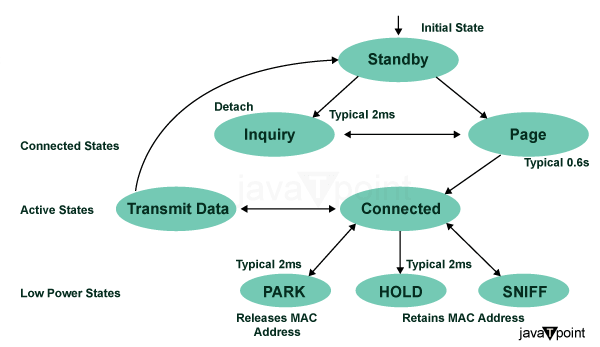Modes of Connection BluetoothBluetooth is a generation that nearly every device is in use these days, it turned into the most famous and safe way of sharing statistics in the early times. Bluetooth uses a brief-range wi-fi generation that is used for changing data among constant and cell devices over quick distances and constructing non-public location networks. Bluetooth holds a transmission restriction of up to 2.Five milliwatts, the reason for its short-range transmission. 
The country of any given Bluetooth unit (having a required strength delivery) can broadly be labeled as standby or connection. A tool in standby state is not lively in any network. A Bluetooth-enabled tool within the connection nation is synchronized to a piconet. Such a device may be in one of the following 4 modes:
Sniff ModeThe Sniff mode on devices has the highest responsibility cycle of the three power-saving modes or the least power efficiency. By decreasing the responsibility cycle, or growing the listening c program language period, power efficiency is attained.
Active ModeWhen in Active mode, a Bluetooth device actively participates inside the piconet by sending and receiving records/managing packets. In order to differentiate among energetic Slaves and parked contributors, every energetic Slave in a piconet is given a distinct three-bit AM_ADDR (Active Member copes with).
Park ModeWhen a slave comes to a decision to remain inactive within the piconet for a period of time that is relatively longer than the Sniff and Hold intervals, it enters Park mode. The tool maintains its synchronization inside the piconet while last uninvolved in the traffic. In order to re-synchronize, parked gadgets give up their MAC (AM_ADDR address) and sometimes pay attention to broadcast messages from the grasp. Of the three strength-saving modes, it offers the highest power efficiency. Devices that occasionally want to communicate with a Master can be accommodated in park mode. Following a periodic beacon despatched by means of the Master, a Slave exits Park mode through sending a packet to the Master requesting a transition from Park to Active mode. The beacon interval is programmable. Since parked members give up their MAC addresses, each of them is given two extra addresses to assist Master preserve tune of them.
Hold ModeThe electricity efficiency of devices in Hold mode is in the middle of the 3 energy-saving modes. The tool is briefly rendered inactive to boost electricity efficiency. Only an internal timer inside the tool is operational during a Hold.
Next TopicNoisy Channel protocols
|
 For Videos Join Our Youtube Channel: Join Now
For Videos Join Our Youtube Channel: Join Now
Feedback
- Send your Feedback to [email protected]
Help Others, Please Share










